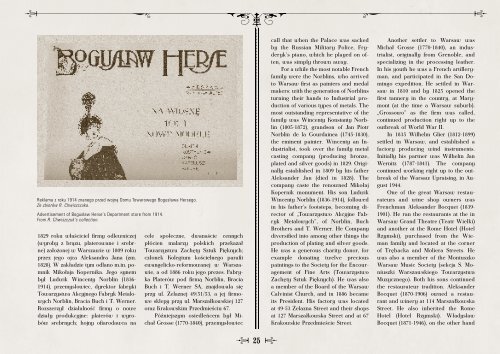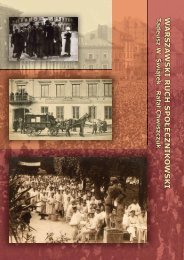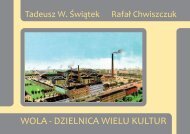You also want an ePaper? Increase the reach of your titles
YUMPU automatically turns print PDFs into web optimized ePapers that Google loves.
Reklama z roku 1914 znanego przed wojną Domu Towarowego Bogusława Hersego.<br />
Ze zbiorów R. Chwiszczuka.<br />
Advertisement of Bogusław Herse’s Department store from 1914.<br />
From R. Chwiszczuk’s collection.<br />
1829 roku właściciel fi rmy odlewniczej<br />
(wyroby z brązu, platerowane i srebrne)<br />
założonej w Warszawie w 1809 roku<br />
przez jego ojca Aleksandra Jana (zm.<br />
1828). W zakładzie tym odlano m.in. pomnik<br />
Mikołaja Kopernika. Jego synem<br />
był Ludwik Wincenty Norblin (1836-<br />
1914), przemysłowiec, dyrektor fabryki<br />
Towarzystwa Akcyjnego Fabryk Metalowych<br />
Norblin, Bracia Buch i T. Werner.<br />
Rozszerzył działalność fi rmy o nowe<br />
działy produkcyjne: platerów i wyrobów<br />
srebrnych; hojny ofi arodawca na<br />
cele społeczne, dwanaście cennych<br />
płócien malarzy polskich przekazał<br />
Towarzystwu Zachęty Sztuk Pięknych;<br />
członek Kolegium kościelnego parafi i<br />
ewangelicko-reformowanej w Warszawie,<br />
a od 1886 roku jego prezes. Fabryka<br />
Platerów pod fi rmą Norblin, Bracia<br />
Buch i T. Werner SA, znajdowała się<br />
przy ul. Żelaznej 49/51/53, a jej fi rmowe<br />
sklepy przy ul. Marszałkowskiej 127<br />
oraz Krakowskim Przedmieściu 67.<br />
Późniejszym osiedleńcem był Michał<br />
Grosse (1770-1840), przemysłowiec<br />
25<br />
call that when the Palace was sacked<br />
by the Russian Military Police, Fryderyk’s<br />
piano, which he played on often,<br />
was simply thrown away.<br />
For a while the most notable French<br />
family were the Norblins, who arrived<br />
to Warsaw fi rst as painters and medal<br />
makers: with the generation of Norblins<br />
turning their hands to Industrial production<br />
of various types of metals. The<br />
most outstanding representative of the<br />
family was Wincenty Konstanty Norblin<br />
(1805-1872), grandson of Jan Piotr<br />
Norblin de la Gourdainea (1745-1830),<br />
the eminent painter. Wincenty an Industrialist,<br />
took over the family metal<br />
casting company (producing bronze,<br />
plated and silver goods) in 1829. Originally<br />
established in 1809 by his father<br />
Aleksander Jan (died in 1828). The<br />
company caste the renowned Mikołaj<br />
Kopernik monument. His son Ludwik<br />
Wincenty Norblin (1836-1914), followed<br />
in his father’s footsteps, becoming director<br />
of „Towarzystwo Akcyjne Fabryk<br />
Metalowych”, of Norblin, Buch<br />
Brothers and T. Werner. He Company<br />
diversifi ed into among other things the<br />
production of plating and silver goods.<br />
He was a generous charity donor, for<br />
example donating twelve precious<br />
paintings to the Society for the Encouragement<br />
of Fine Arts (Towarzystwo<br />
Zachęty Sztuk Pięknych). He was also<br />
a member of the Board of the Warsaw<br />
Calvinist Church, and in 1886 became<br />
its President. His factory was located<br />
at 49-53 Żelazna Street and their shops<br />
at 127 Marszałkowska Street and at 67<br />
Krakowskie Przedmieście Street.<br />
Another settler to Warsaw was<br />
Michał Grosse (1770-1840), an industrialist,<br />
originally from Grenoble, and<br />
specializing in the processing leather.<br />
In his youth he was a French artilleryman,<br />
and participated in the San Domingo<br />
expedition. He settled in Warsaw<br />
in 1810 and by 1825 opened the<br />
fi rst tannery in the country, at Marymont<br />
(at the time a Warsaw suburb).<br />
„Grossowo” as the fi rm was called,<br />
continued production right up to the<br />
outbreak of World War II.<br />
In 1835 Wilhelm Glier (1812-1899)<br />
settled in Warsaw, and established a<br />
factory producing wind instruments.<br />
Initially his partner was Wilhelm Jan<br />
Wernitz (1787-1841). The company<br />
continued working right up to the outbreak<br />
of the Warsaw Upraising, in August<br />
1944.<br />
One of the great Warsaw restaurateurs<br />
and wine shop owners was<br />
Frenchman Aleksander Bocquet (1839-<br />
1901). He ran the restaurants at the in<br />
Warsaw Grand Theatre (Teatr Wielki)<br />
and another at the Rome Hotel (Hotel<br />
Rzymski), purchased from the Wieman<br />
family and located at the corner<br />
of Trębacka and Moliera Streets. He<br />
was also a member of the Moniuszko<br />
Warsaw Music Society (sekcja S. Moniuszki<br />
Warszawskiego Towarzystwa<br />
Muzycznego). Both his sons continued<br />
the restaurateur tradition. Aleksander<br />
Bocquet (1870-1906) owned a restaurant<br />
and winery at 114 Marszałkowska<br />
Street. He also inherited the Rome<br />
Hotel (Hotel Rzymski). Władysław<br />
Bocquet (1871-1946), on the other hand




